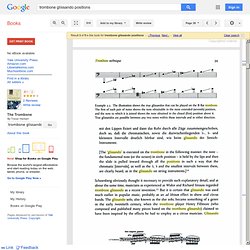

The Clarinet of the Twenty-First Century. Fingeringcharts. The Trombone Glissando Explained For Arrangers and Composers. (For the examples used in this article, pitches are defined as middle C = C4.)

Back To Basics One of the trombone's fundamental features is the trombone "slide" from note to note, also known as the "glissando," (or "gliss" for short) a continuous slide between two notes. A true glissando is rare in the world of instruments—the violin (and other non- fretted string instruments, including the fretless bass), along with slide whistle, Theremin, and human voice come to mind as being able to produce a true glissando. The trombone's glissando is featured in orchestra and band music for a variety of reasons and effects, from comical to threatening. Many a community band has had to endure the stock arrangements of the songs featuring the trombone section showing off their glissando slides. In jazz music, and particular, Dixieland jazz, the glissando is standard fare. What Notes Are Possible For a Gliss? Here is the basic chart, the key to how to write the gliss for the trombone:
The Trombone - Trevor Herbert. Books.google.com.co - This is the first comprehensive study of the trombone in English.

It covers the instrument, its repertoire, the way it has been played, and the social, cultural, and aesthetic contexts within which it has developed. The book explores the origins of the instrument, its invention in the fifteenth century,... Trombone Page 34 The vertical axis on the left shows slide positions, the horizontal axis on top the partials of the harmonic series. Page 38 trombone obbligatos, Carter observed a shift from sharp to flat keys - a change coinciding with and probably caused by a sharpening of the ... Page 39 The illustration shows the true glissandos that can be played on the B flat trombone. Page 40 Tailgate players used glissando not just decoratively but structurally, to emphasize cadence points, and they often ... Page 270 It is often thought that tailgate players used glissando because they lacked the slide technique to enunciate clear phrases and ... The Woodwind Fingering Guide - Online fingering charts for flute, piccolo, oboe, clarinet, saxophone, bassoon, recorder, tin whistle, fife, charanga flute, shakuhachi flute, uilleann pipes, and sarrusophone.
Modern Flute Fingering Chart. Larry Krantz Flute Pages: Extended Techniques Resource Page. Whisper tones (Whistle tones, flageolets).... are very faint whistly sounds that are made by blowing VERY gently into the embouchure hole, with the flute in normal playing position.

They can be produced using any of the standard fingerings. On each fingering, many members of the harmonic series for that fingering can be produced. Here are whisper tones using the high register fingerings. Using the low register fingerings, you can get the harmonic series in whisper tones. Here is one using the low B fingering that gets all the way up to the 16th partial--B above high B. A sound that is related to the whisper tone is the ghost tone. For Robert Dick materials, click on the publisher link. Circular Breathing for the flutist by Robert Dick. Easing Into Extended Technique by Linda L.
Fish Are Jumping for solo flute, by Robert Dick. Flying Lessons: Six Contemporary Concert Etudes, Vol. 1 and Vol. 2 by Robert Dick. Lookout by Robert Dick. A Modern Guide to Fingerings for the Flute by James J. Jay C. Easton: Extended saxophone techniques. Frans Absil Music - Instrument names and orchestral terms. This page gives an overview of instrument names and orchestral terms in English, Italian, French and German. Frequently used instrument names are presented in singular and plural, and instrument name abbreviations are shown in the last column of the table. Names and orchestral terms are given for various categories in separate tables. Reference sources are listed at the bottom of the page.
Reference sources Here's a list of reference sources: Samuel Adler, The Study of Orchestration, 2nd Edition W.W. Harp Spectrum. Mats Möller - New sounds for flute. Fingering%20Chart%20-%20Simple.